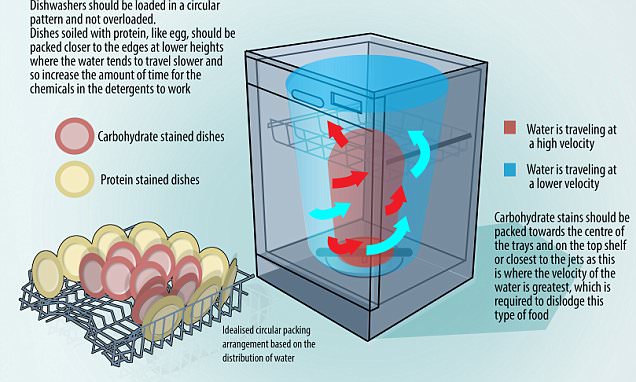Have you ever wondered how dishwashers make our lives so much easier? These handy appliances have revolutionized the way we handle dirty dishes, saving us time and effort. From scrubbing pots to rinsing plates, dishwashers do it all with a simple push of a button. In this guide, we'll dive into the fascinating world of dishwashers, exploring their inner workings and the key components that make them so effective.
Basic Components of a Dishwasher

Understanding the basic components of a dishwasher is essential to grasp how they function. Each part plays a crucial role in ensuring that your dishes come out sparkling clean. Let's break down the main components:
- Water Inlet Valve: This valve controls the water flow into the dishwasher. When you start a cycle, it opens to fill the dishwasher with water.
- Spray Arms: Usually located at the bottom and sometimes the middle of the dishwasher, these arms rotate and spray water to wash away food particles. The design of the spray arms ensures that every inch of your dishes gets cleaned.
- Heating Element: This component heats the water to the optimal temperature for cleaning. Hot water is crucial for dissolving grease and sanitizing dishes effectively.
- Filter: The filter traps food particles and debris during the wash cycle, ensuring the water remains clean and effective. Regular cleaning of this filter is essential for optimal performance.
- Detergent Dispenser: This is where you add your dishwashing detergent. It releases the detergent at the right time during the wash cycle to maximize cleaning power.
- Control Panel: The control panel is the brain of the dishwasher. It allows you to select different wash cycles, adjust settings, and monitor the status of the wash.
Each of these components works together seamlessly to deliver that sparkling clean finish we all love. Understanding these basics helps us appreciate the technology behind this everyday appliance!
Also Read This: How to Use Makeup Fixer: A Guide to Long-Lasting Makeup
The Washing Cycle Explained

Understanding the washing cycle of a dishwasher can feel like diving into a complex machine, but it’s really quite straightforward! Let’s break it down step by step.
1. *Pre-Wash Phase: The cycle kicks off with a pre-wash. This phase involves spraying hot water mixed with detergent onto the dishes. It’s like giving your plates a warm-up before the main event! This step helps to loosen any stubborn food particles.
2. Main Wash Phase: Once the pre-wash is done, the dishwasher enters the main wash phase. Here, the water temperature rises, usually between 120°F to 150°F (49°C to 65°C). The spray arms rotate and distribute water evenly, ensuring every surface of your dishes is cleaned. Most dishwashers use a combination of high-pressure jets and swirling water to tackle grease and grime effectively.
3. Rinsing Phase: After the main wash, the machine drains the dirty water and moves into the rinsing phase. This step is crucial as it removes any leftover detergent and food residues. Some dishwashers use a rinse aid to help prevent spots and enhance drying.
4. Drying Phase*: Finally, the dishwasher enters the drying phase. This can be done in a few ways, such as using a heating element or relying on condensation drying. The goal is to leave your dishes perfectly dry and ready to put away!
Also Read This: What to Do When Dailymotion Is Not Working
Common Features and Technologies
Modern dishwashers come packed with features that make them more efficient and user-friendly. Here are some common technologies you might find:
- Smart Controls: Many dishwashers now offer Wi-Fi connectivity, allowing users to control and monitor cycles from their smartphones. Imagine starting a load while you’re still at the grocery store!
- Sensor Cleaning: Some models use sensors to detect the soil level of dishes. This feature adjusts the wash cycle's duration and intensity, saving water and energy.
- Multiple Wash Zones: High-end dishwashers often have adjustable racks or zones that allow you to wash different types of items at the same time. For instance, you can use a gentle cycle for glassware while running a heavier cycle for pots and pans.
Here’s a quick comparison of some popular dishwasher technologies:
| Technology | Description |
|---|---|
| Soil Sensors | Detects how dirty the dishes are to optimize washing time. |
| Quiet Operation | Sound-dampening materials that make dishwashers ultra-quiet. |
| Energy Efficiency | Models that meet ENERGY STAR standards to save on utility bills. |
With these features, doing the dishes becomes less of a chore and more of a breeze! Remember to explore the options available when shopping for your next dishwasher—you’d be surprised at what’s out there!
Also Read This: How to Find Restricted Content on YouTube in 2024
Tips for Efficient Dishwasher Use
Maximizing the efficiency of your dishwasher not only saves you time but also helps in conserving water and energy. Here are some practical tips to ensure your dishwasher runs at its best:
- Load Properly: Arrange your dishes in a way that allows water to reach all surfaces. Place larger items like pots and pans on the bottom rack while the smaller, more delicate items go on top.
- Don’t Overload: While it might be tempting to cram everything in, overloading can prevent proper cleaning. Make sure there’s enough space for water to circulate freely.
- Scrape, Don't Rinse: Instead of rinsing dishes, just scrape off food bits. Modern dishwashers are designed to handle some food residue, and this conserves water.
- Use the Right Detergent: Choose a detergent specifically formulated for dishwashers. Using the wrong type can lead to poor cleaning results or excessive suds.
- Run Full Loads: Wait until you have a full load before running the dishwasher. This maximizes water and energy efficiency.
- Regular Maintenance: Keep your dishwasher clean and well-maintained. Check filters, spray arms, and seals regularly to ensure everything is functioning correctly.
By following these simple tips, you can enhance your dishwasher's performance and ensure sparkling clean dishes every time!
Conclusion and Resources
Understanding how dishwashers work and implementing efficiency tips can transform your dishwashing routine. Not only do they save time, but they also contribute to a more sustainable lifestyle. Here’s a quick recap:
- Proper loading and avoiding overloading are key to effective cleaning.
- Using the right detergent and regular maintenance keeps your dishwasher in top shape.
- Running full loads is a smart way to conserve energy and water.
For further reading and to dive deeper into the world of dishwashers, check out these resources:
| Resource | Link |
|---|---|
| The Ultimate Dishwasher Buying Guide | example.com/buying-guide |
| Common Dishwasher Problems and Solutions | example.com/problems-solutions |
| Eco-Friendly Dishwashing Tips | example.com/eco-tips |
Embrace the convenience of dishwashers, and you’ll never look back!
 admin
admin








